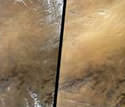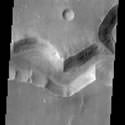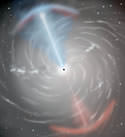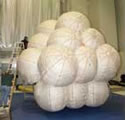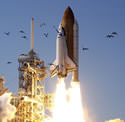
Image credit: NASA
The space shuttle Atlantis lifted off from Cape Canaveral this morning, carrying seven astronauts and headed for the International Space Station. Liftoff occurred at 2044 GMT (4:44pm EDT), four days late because of a leaky fuel line on the shuttle’s launch pad. The shuttle is expected to dock with the station on Wednesday, and astronauts will begin the first of four spacewalks to install a new truss that will serve as a backbone for the station.
With the International Space Station and the Expedition Four crew orbiting high overhead, the shuttle Atlantis lifted off this afternoon on a complex mission to install a 43-foot long truss structure as the backbone for future expansion of the orbital outpost.
Commander Mike Bloomfield, Pilot Steve Frick, Flight Engineer Ellen Ochoa and spacewalkers Steve Smith, Rex Walheim, Jerry Ross and Lee Morin rocketed away from Launch Pad 39-B at the Kennedy Space Center at 3:44 p.m. Central time as the ISS orbited over the Atlantic Ocean due east of the northeastern United States at an altitude of 240 statute miles.
Launch occurred with only 12 seconds left in the 5-minute launch window due to a brief delay caused by a momentary ground launch system software glitch at the Launch Control Center at the Florida spaceport which paused the countdown at the T-minus 5-minute mark. Once the problem was solved, the countdown resumed.
Atlantis? launch marked a milestone as Ross became the first human to fly in space seven times, breaking a record of six flights previously held by Ross and fellow American astronauts John Young, Story Musgrave, Franklin Chang-Diaz and Curt Brown. No Russian cosmonaut has flown in space more than five times.
Now in their fifth month in orbit, Expedition Four Commander Yury Onufrienko and Flight Engineers Carl Walz and Dan Bursch were able to watch Atlantis? launch through a video uplink from flight controllers in Houston. Atlantis? arrival will mark the first visitors for the Expedition Four crewmembers since their launch back in December.
Less than nine minutes later, Atlantis and its crewmembers settled into orbit as work began to prepare the shuttle for its planned 11-day mission and for a series of rendezvous maneuvers to reach the station on Wednesday morning. Atlantis will actually have to lap the ISS as a result of those maneuvers before its scheduled docking with the outpost Wednesday.
After Atlantis? payload bay doors are opened and approval is given for the start of orbital operations, the seven crewmembers will unstow computers and other gear required for the mission.
If all goes as planned, Atlantis will link up to the station Wednesday just after 11 a.m. Central time, setting the stage for the installation of the S0 (S-Zero) Truss on Thursday morning on the Destiny Laboratory and the first of four spacewalks to mate and activate the new component to Destiny. The S-Zero Truss will serve as a platform upon which other trusses will be attached and additional solar arrays will be mounted in future assembly flights to form a structure longer than the length of a football field. The new truss will also serve as a primary electrical switching station to route power from the stations? arrays to various modules and components.
The shuttle crew will begin its first sleep period at 8:44 p.m. Central time and will be awakened at 4:44 Tuesday morning to begin its first full day in orbit, designed to test the ship?s robot arm, spacesuits and rendezvous equipment which will be used over the next few days.
Original Source: NASA News Release

